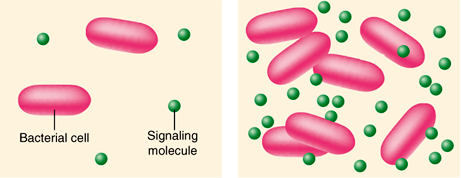Quorum sensing is a process by which bacteria monitor their own population density by detecting the levels of signal molecules that are released by the bacteria. It is a unique phenomenon of cell-to-cell communication, enabling microorganisms to communicate and coordinate their behavior and activity via the secretion of chemical autoinducer signaling molecules in a population-dependent manner. The secreted autoinducers accumulate in environments that can sustain a sufficiently dense population, or quorum, of the signal-producing bacteria, and the bacteria then "measure" the number (that is, concentration) of signal molecules within a population, as well as the number of bacteria (that is, cell density). When the concentration of the signal molecules reaches a critical level, the quorum-sensing bacterial population responds through the concerted expression of specific target genes. Thus, this provides bacteria with the capacity to behave as a collective group. See also: Bacteria; Bacterial physiology and metabolism; Bacteriology; Gene; Microbial ecology; Microbiology

In general, the diverse bacteria living together in an environment can detect different classes of signal molecules. Each bacterial species relies on the production of, accumulation of, and subsequent response to specific diffusible signal molecules to sense its population. In other words, quorum sensing enables bacteria to recognize other members of their specific species (self or intraspecies quorum sensing) in a mixed population; it also may allow bacteria to sense the ratio of self to other bacterial species (interspecies quorum sensing). In both cases, quorum sensing leads to modulation of gene expression and allows behavior adaptations or responses that could optimize survival (for example, adaptations to ensure nutrient availability or to avoid toxic compounds, and defenses against competing or predatory microorganisms). In addition, by acting collectively, individual bacteria can acquire some of the characteristics of a multicellular organism. For example, this coordinated behavior occurs in the formation of biofilms (highly structured communities of microorganisms that are surface-associated or attached to one another, and are enclosed within a self-produced protective extracellular matrix). See also: Biofilm; Microbial interactions; Microbial survival mechanisms
Several quorum-sensing systems have been investigated and demonstrated, including many notable systems that involve the regulation of genes necessary for the successful establishment of pathogenic and symbiotic interactions. Some examples of bacteria that employ quorum sensing include Vibrio fischeri (a symbiotic marine bacterium that uses quorum sensing to control the production of luminescence when it is associated with its animal host), Streptococcus pneumoniae [a pneumonia-causing pathogen that uses quorum sensing to regulate the absorption of deoxyribonucleic acid (DNA) from the environment into its genetic material], Agrobacterium tumefaciens [a plant pathogen that uses quorum sensing to regulate the transfer of a plasmid (a circular extrachromosomal genetic element) necessary for virulence], Pseudomonas aeruginosa (a human opportunistic pathogen that uses quorum sensing to produce its virulence factors), and Staphylococcus aureus (a bacterium that, when pathogenic, uses quorum sensing to produce its protein toxins). See also: Bacterial luminescence; Human susceptibility to Staphylococcus aureus; Medical bacteriology; Pathogen; Pseudomonas; Streptococcus pneumoniae (pneumococcus); Symbiosis





